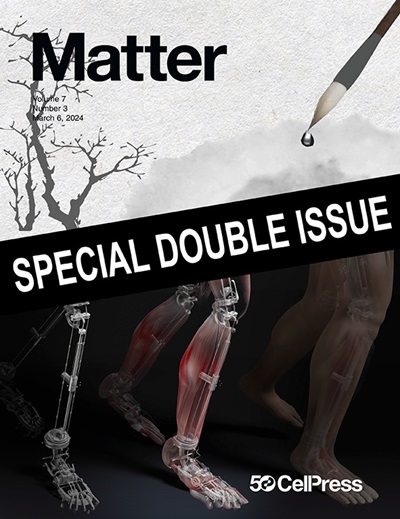神经电极植入过程中急性炎症反应的术中及时空定位
IF 17.3
1区 材料科学
Q1 MATERIALS SCIENCE, MULTIDISCIPLINARY
引用次数: 0
摘要
在脑机接口(BCI)植入过程中,术中和时空监测神经炎症指数对于确保手术的安全性和有效性至关重要。目前的生物分子检测方法无法获得时空分辨的炎症谱,这对于指导术中微电极的放置非常重要。本研究提出了一种术中时空急性炎症探测器(ISAID),该探测器利用基于液滴的采样和多路氧氮化钛(TiNO)等离子体生物传感来评估植入皮质内微电极期间的局部炎症。通过独立的采样液滴和微调的tino生物传感器,ISAID实现了精确、敏感和集成的生物传感采样,以进行细胞因子检测,空间分辨率低至610 μm,快速等效生物测定时间为1.25 min。该系统还允许多种ISAID生物传感模式,实现空间炎症映射和多细胞因子分析。体内小鼠模型的炎症细胞因子定量分析证明了该系统的准确性和实用性优势。本文章由计算机程序翻译,如有差异,请以英文原文为准。

Intraoperative and spatiotemporal mapping of acute inflammation response during neuroelectrode implantation
Intraoperative and spatiotemporal monitoring of neuroinflammatory indices during brain-computer interface (BCI) implantation is essential for ensuring safety and efficacy of the procedure. Current biomolecular detection approaches are unable to obtain spatiotemporally resolved inflammatory profiling, which is important for guiding the placement of microelectrodes intraoperatively. This study presents an intraoperative spatiotemporal acute inflammation detector (ISAID) that harnesses droplet-based sampling and multiplexed titanium oxynitride (TiNO) plasmonic biosensing to assess local inflammation during the insertion of intracortical microelectrodes. Through freestanding sampling droplets and fine-tuned TiNO-based biosensors, the ISAID achieved precise, sensitive, and integrated sampling to biosensing for cytokine detection with a spatial resolution down to 610 μm and a fast equivalent bioassay time of 1.25 min. The proposed system also allows multiple ISAID biosensing modes, enabling both spatial inflammation mapping and multi-cytokine analysis. Quantitative analyses of inflammatory cytokines with in vivo mouse models demonstrate the accuracy and practical advantages of the system.
求助全文
通过发布文献求助,成功后即可免费获取论文全文。
去求助
来源期刊

Matter
MATERIALS SCIENCE, MULTIDISCIPLINARY-
CiteScore
26.30
自引率
2.60%
发文量
367
期刊介绍:
Matter, a monthly journal affiliated with Cell, spans the broad field of materials science from nano to macro levels,covering fundamentals to applications. Embracing groundbreaking technologies,it includes full-length research articles,reviews, perspectives,previews, opinions, personnel stories, and general editorial content.
Matter aims to be the primary resource for researchers in academia and industry, inspiring the next generation of materials scientists.
 求助内容:
求助内容: 应助结果提醒方式:
应助结果提醒方式:


